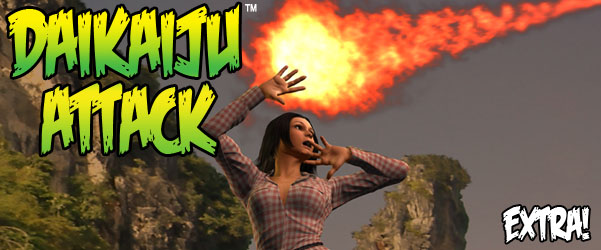
This is the second part of the after-story notes for Daikaiju Attack.
Click here to read Episode 1. Click here to get “Daikaiju vs. Cthulhu” – a Daikaiju Attack story!
Click here to get my newest book, WHITE ZOMBIE for Print & Kindle or here for All Formats!
Click here to join the Daikaiju Attack Facebook group.
PART TWO: GIANT MONSTERS ON THE RISE
So, I’d decided to write a serialized monster story and publish a new chapter on my website every week, but I needed a topic.
Fortunately, the impending release of Pacific Rim (and a then-rumored Godzilla movie in 2014) provided quick inspiration.
It was possible that we were about to enter a new age of Giant Monster Mania.
Just the thought of it made me grin.
Because, as I mentioned in Part One of this essay, I’d been wanting to write a daikaiju story for ages. Heck, I’d even written a thinly disguised kaiju tale in the Magic: The Gathering anthology, Monsters of Magic.
In that moment, all my marketing and story-writing inspirations converged, and Daikaiju Attack was born.
The ideas for the plot came together quickly, which was good because I wanted to start posting episodes as soon as possible. I decided to make the project a high-wire writing act (almost like my Tournament of Death series), with me composing the chapters only slightly ahead of when I’d be releasing them.
Fast writing and rapid release was the only way to do it if I wanted to have chapters up by the time Pacific Rim hit the theaters.
Because of my TOD experience, I knew that I could start my giant monster epic on the fly and still end up with a satisfying story that didn’t feel like I’d just “made it up while I was going.”*
With a topic chosen and prospective deadlines looming, I set to work.
Characters, situations, and monsters immediately began to flood into my brain.
I decided to set the series in the 1960s, the classic era of giant monsters. (The Showa era, for those of you in-the-know.) I chose 1966 because it was right after the three best films in the original Godzilla series (after the first): Mothra vs. Godzilla (a.k.a. Godzilla vs. the Thing), Ghidorah, the Three-Headed Monster, and Invasion of Astro-Monster (a.k.a. Monster Zero).
Then I compiled a roster of archetype monsters and a list of Japanese words that I might use to name them. I started a huge bible for the series with facts about Japan (How far is it from Kobe to Okayama? What kind of helicopters did the military use in 1966?), web links, and other notes to assist me as I wrote.
It helped that I’d grown up during the 1960s, and also that the classic Godzilla and Gamera films formed a strong part of my childhood. There were things that came up during the writing that I just knew from being there, little details that wouldn’t have even occurred to a younger monster-kid writer. (I will admit, though, to not remembering just how isolated China had been before the Nixon visit, until one of my fact-checkers caught my goof. Real head slap moment, there.)
Then I began writing … and writing … and writing.
The core characters showed up fairly early during the planning stage—a daikaiju stock company of reporters, scientists, and military folks, with some rock-and-rollers thrown in for fun. Some psychic overtones went into the mix, because I always enjoyed that idea/subplot (see Ghidorah).
I quickly knew how my story began—with a meteor shower (hearkening back to Ghidorah, again)—and that it ended with a huge monster battle. I knew that the main character would be a photographer who’d just caught her boyfriend cheating, and I knew that she’d find a monster-spawning meteorite in a crater.
But after that… Almost everything remained up in the air.
That’s the joy—and terror—of “live” writing.
I worked on the story in chunks, usually 4-6 episodes at a time. When I started, I thought the tale would last 24 chapters at most.
But the story and its intrepid crew went where they wanted to, and far be it from me to stop them so long as it all turned out well in the end. Good characters do take on a life of their own, and it’s the surprises they bring to a story that makes writing fun.
*Interestingly, while Daikaiju Attack was running on my site, I simultaneously wrote and delivered Tournament of Death 3 during the 2014 Sochi Olympics. That’s right, I was working on two “live” novels at the same time. Kids, don’t try this at home!
All contents TM & © 2014 Stephen D. Sullivan. All Rights Reserved.





Fun watching it unfold too! Great idea. Not sure I could write that way… http://cverstraete.com GIRL Z: My Life as a Teenage Zombie